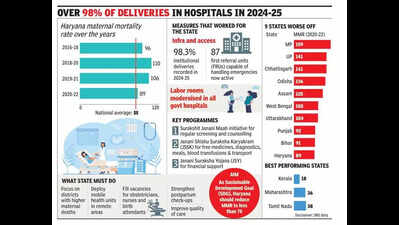Haryana Maternal Mortality Rate: Maternal Mortality Rate in Haryana Improves by 17 Points, Nearly Matches National Average, ET HealthWorld

Gurgaon: Haryana has witnessed a 17-point improvement in its maternal mortality ratio (MMR), translating to around 300 mothers who survived childbirth in 2020-22, a bulletin released by the Sample Registration System has shown.According to the report, the state's MMR fell from 106 to 89 over the two-year period, marking a key milestone in its journey towards safer motherhood. Although this progress is significant, the figure is still marginally above the national average of 88.This improvement isn't just about numbers — it represents how lives were saved through systematic healthcare reforms and enhanced institutional care.Officials pointed out that there was a rise in institutional deliveries — at over 98% — as the public health system had become more responsive with emergency obstetric care units and high-risk pregnancy protocols."This surge in institutional deliveries reflects a growing public confidence in govt healthcare services," said Dr RS Dhillon, mission director at National Health Mission (NHM), Haryana.Behind these improving numbers lies a robust infrastructure upgrade. The govt has modernised labour rooms in all govt hospitals, equipping them with essential drugs, supplies, and equipment to ensure safe birthing conditions.
The number of first referral units, which are capable of handling obstetric emergencies, including C-sections, has also grown to 87. The state has implemented comprehensive protocols for high-risk pregnancy management, supported by initiatives like Surakshit Janani Maah and the extended Pradhan Mantri Surakshit Matritva Abhiyan (e-PMSMA). These programmes, officials said, focus on regular screening, counselling, and early interventions.According to officials, financial barriers to maternal care have been significantly reduced through schemes like Janani Shishu Suraksha Karyakram (JSSK) and Janani Suraksha Yojana (JSY), providing free medicines, diagnostics, meals, blood transfusions, and even transport services to pregnant women."In addition, maternal death reviews and audits were regularly conducted at the state and district levels," an official said.The ‘zero home delivery' campaign has also been instrumental in raising awareness about professional medical assistance during childbirth. Additionally, the state has mandated districts to improve ante-natal care and maintain dashboards to track high-risk pregnancies at all health centres.However, DB Saharan, retired director of health services, said the govt should now focus on the road ahead. "To achieve the sustainable development goal of reducing MMR below 70 per 1 lakh live births, Haryana must maintain its momentum while focusing on accountability, equity, and education," he added.The state's progress in reducing maternal mortality — defined as death during pregnancy or within six weeks of childbirth — demonstrates "the impact of targeted interventions and systematic healthcare improvements", an official said."The challenge now lies in sustaining this progress while ensuring no mother is left behind in accessing quality maternal care," an official said.













